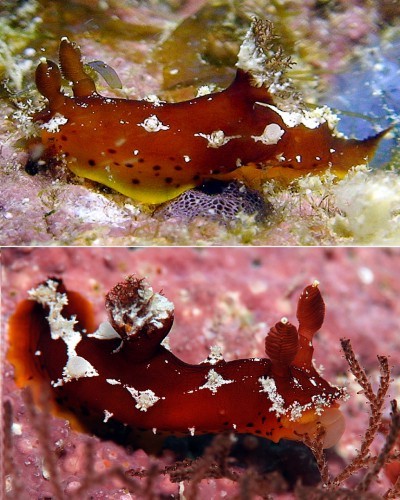
Plocamopherus maculapodium
Valles & Gosliner, 2006
Order: NUDIBRANCHIA
Suborder: DORIDINA
Superfamily: ANADORIDOIDEA
Family: Polyceridae
Subfamily: Triophinae
DISTRIBUTION
Wide Indo-West Pacific distribution with records from Philippines, Marshall Islands, Papua New Guinea & Zanzibar.
PHOTO
Locality: Kwajalein Atoll, 6 m, Marshall Islands, Pacific, 8 February 2009, Under rock on shallow lagoon reef. Length: 19 x 4 mm. Photographer: Jeanette & Scott Johnson.
The body is a uniform brown to reddish brown with some minute white spots, usually in a line around the mantle edge. The colour lightens down the sides of the body, becoming almost yellow on the foot. Dark brown to black spots are scattered over the foot. There are three pairs of lateral processes arranged along the mantle edge, the most anterior pair being about midway between the rhinophores and the gills, and the most posterior pair being just behind the gills. These lateral processes are white, and the anterior two on each side have branched papillae, while the posterior pair are tipped with a spherical tubercle. The anterior mantle is developed into a flap overhanging the mouth. It has white branched papillae along its edge. From the posterior lateral process on each side an irregular white line runs into the dorsal midline where it joins its partner from the other side and runs posteriorly to the tip of the foot. Branched papillae occur along this posterior midline.
The rhinophores are large and inflated. They are the same reddish brown as the body and have a white tubercle at the tip. The gills have an outer brown base, then a white region before branching. The terminal branches are dark brown. It grows to at least 25 mm in length, and feeds on arborescent bryozoans.
Note: This species has previously been known on the Forum as Plocamopherus sp. 1.
-
Valles, Y. & T.M. Gosliner. 2006. Shedding light onto the genera Kaloplocamus and Plocamopherus (Mollusca: Nudibranchia) with description of new species belonging to these unique bioluminescent dorids. The Veliger, 48: 178-205.
Rudman, W.B., 2009 (May 28) Plocamopherus maculapodium Valles & Gosliner, 2006. [In] Sea Slug Forum. Australian Museum, Sydney. Available from http://www.seaslugforum.net/find/plocmacup
Related messages
Re: Plocamopherus from Philippines
May 28, 2009
From: Scott Johnson
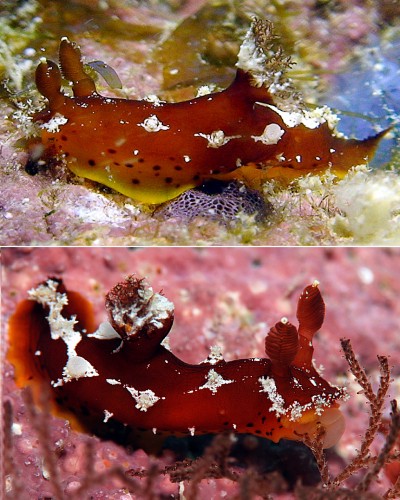
Concerning message #884:
Hi Bill,
I noticed the reference to Plocamopherus sp. 1 in the recent discussion of Plocamopherus lucayensis [message #22479]. Plocamopherus sp. 1 appears to be the one named a couple of years back by Valles & Gosliner (2006) named Plocamopherus maculapodium. We have also run across one specimen here in the Marshall Islands. It was eating the bryozoan in two of the photos.
Locality: Kwajalein Atoll, 6 m, Marshall Islands, Pacific, 8 February 2009, Under rock on shallow lagoon reef. Length: 19 x 4 mm. Photographer: Jeanette & Scott Johnson.
-
Valles, Y. & T.M. Gosliner. 2006. Shedding light onto the genera Kaloplocamus and Plocamopherus (Mollusca: Nudibranchia) with description of new species belonging to these unique bioluminescent dorids. The Veliger, 48: 178-205.
A few other pictures are on http://www.underwaterkwaj.com/nudi/phanerobranchs/e573.htm
Scott
uwkwaj@yahoo.com
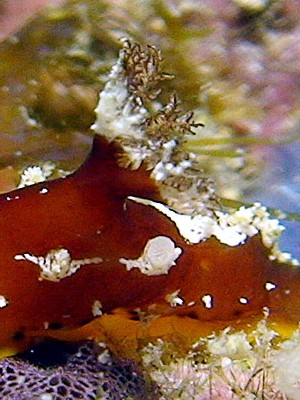


Dear Scott,
Thanks for these photos. I must say I had not associated the photo of Plocamopherus sp. 1 with P. maculapodium, because in the original description the animal in their photo is quite red and Valles & Gosliner describe it as red. However your photos show the black or dark brown spots along the edge of the foot which gives this species its name [macula = spotted, podium = foot].
It is good to get confirmation that bryozoans are the preferred food of species of Plocamopherus.
Best wishes,
Bill Rudman
Re: Plocamopherus from Philippines
May 29, 1999
From: Kathe R. Jensen
Note added 28 May 2009: This has been named Plocamopherus maculapodium, See message #22501.
To Mike Miller about Plocamopherus from Philippines.
There are two species of Plocamopherus described from Ambon Island, Indonesia by Bergh in 1890. These were described from preserved specimens so colouration is unknown. They are P. amboinensis and P. indicus.
Kathe R. Jensen
KRJensen@zmuc.ku.dk
Jensen, K.R., 1999 (May 29) Re: Plocamopherus from Philippines. [Message in] Sea Slug Forum. Australian Museum, Sydney. Available from http://www.seaslugforum.net/find/894Plocamopherus from Philippines
May 25, 1999
From: Mike Miller
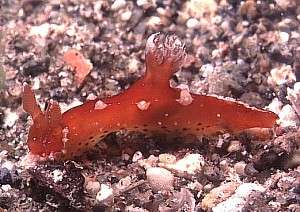
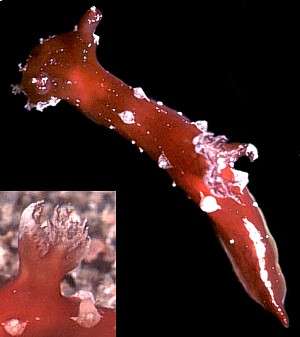
Dear Bill
You will find attached two photos of an animal encountered at Dauin, Negros
Oriental, Philippines on a recent field trip. The presence of posterior lateral bulbs would seem to place the critter in the genus Plocamopherus, but the identity question seems to get a little fuzzy from that point on based on what pictures I could find of Plocamopherus imperialis!
Care to speculate?
Cheers;
Mike Miller
mdmiller@cts.com
Miller, M.D., 1999 (May 25) Plocamopherus from Philippines. [Message in] Sea Slug Forum. Australian Museum, Sydney. Available from http://www.seaslugforum.net/find/884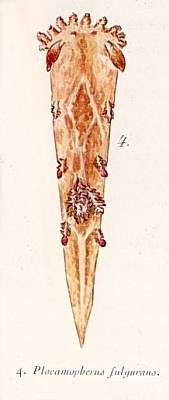
Note added 28 May 2009: This has been named Plocamopherus maculapodium, See message # 22501.
Dear Mike,
Certainly has the hallmark of a Plocamopherusbut not quite the colour or shape of Plocamopherus imperialis which seems to be endemic to southeastern Australia.
Your species could possibly be Plocamopherus fulgurans Risbec, 1928, described from New Caledonia. The colour painting (Plate IV fig 4) - which I copy alongside - has similarities, but I'm afraid that many of Risbec's paintings, done by his father, don't bear much relationship to Risbec's written descriptions. The written description describes a brownish-yellow body with transparent whitish papillae and he does describe the main anatomical features. The white medial dorsal line behind the gills is the same as in your photos. Unfortunately we will probably never be sure.
To my knowledge, Risbec was the first to report the ability of Plocamopherus to produce light from the dorsolateral papillae.
Bill Rudman.
Rudman, W.B., 1999 (May 25). Comment on Plocamopherus from Philippines by Mike Miller. [Message in] Sea Slug Forum. Australian Museum, Sydney. Available from http://www.seaslugforum.net/find/884